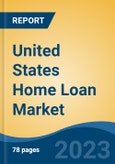Free Webex Call
The United States home loan market is expected to experience significant growth in the forecast period due to several factors. These include the increasing number of potential home loan buyers, automation of the loan process, and the growing trend of digitalization.Speak directly to the analyst to clarify any post sales queries you may have.
10% Free customizationThis report comes with 10% free customization, enabling you to add data that meets your specific business needs.
Home loans, provided by financial institutions, are used to purchase residential properties. These properties can be either finished and ready to move into or still under construction. Home loans are offered by both banks and non-banking financial companies (NBFCs), with interest rates often based on the borrower's credit score. Typically, these loans have terms of up to 30 years and require repayment in equated monthly installments (EMIs).
The demand for mortgages in the United States has seen a significant surge in the past two years, primarily driven by increased home buying during the COVID-19 pandemic. This has resulted in strong demand from the purchase market for banks, nonbank lenders, and mortgage sector investors.
Furthermore, the desire for homeownership in the United States remains strong despite the economic impact of the COVID-19 outbreak. The overall expansion of the economy and the growth in households contribute to the increasing rate of homeownership. In 2020, there was a 2.6% annual growth in homeownership, with over 2.1 million new homeowners. The Midwest and South regions of the United States have higher homeownership rates compared to the Northeast and West. With the rise in homeownership, there will be a significant increase in the demand for home loans.
Automation has played a crucial role in streamlining the home loan process, leading to improved customer experience. The mortgage industry has been adopting technology to speed up and simplify the mortgage application process, resulting in increased access to home financing and home-buying services. Digitalization has been a key driver in this regard, with the U.S. digital payments business expanding at a rate of 23%. These technological advancements aim to accelerate the mortgage application process, reduce costs, and enhance overall client experience. Consequently, increasing digitalization will further boost the United States home loan market.
The growth of nonbank lenders has also had a significant impact on the market. Nonbank lenders have emerged as a viable alternative, particularly for borrowers seeking refinancing. Over the past decade, nonbank mortgage lenders have gained market share, surpassing traditional banks. In 2020, seven out of the top ten mortgage lenders in the United States were nonbanks. These lenders have invested in various technologies to support their operations, ranging from platform modernization to automated compliance. As a result, the growth of nonbank lenders will continue to fuel the expansion of the home loan market.
Overall, the United States home loan market is poised for robust growth, driven by factors such as increasing demand, automation, and the rise of nonbank lenders.
Market Segmentation
The United States home loan market is segmented based on type, end user, tenure period, region, and competitional landscape. Based on type, the market is further fragmented into home purchase, refinance, home improvement, construction, and others (re-sale, etc.). Based on the end user, the market is segmented into employed individuals, professionals, students, entrepreneurs, and others (homemakers, unemployed, retired, etc.). The market is segmented based on the tenure period into less than 5 years, 6-10 years, 11-24 years, and 25-30 years. Based on region, the market is divided into South, West, Midwest, and Northeast.Company Profiles
Bank of America Corporation, JPMorgan Chase & Co., Citigroup, Inc., Wells Fargo & Co., U.S. Bancorp, PNC Financial Services Group, Inc., American Express Company, Ally Financial Inc., Truist Financial Corporation and Goldman Sachs & Co. LLC. are the main players in the market and further strengthening the market growth.Report Scope
In this report, United States home loan market has been segmented into following categories, in addition to the industry trends which have also been detailed below:United States Home Loan Market, by Type:
- Home Purchase
- Refinance
- Home Improvement
- Construction
- Others
United States Home Loan Market, by End User:
- Employed Individuals
- Professionals
- Students
- Entrepreneurs
- Others
United States Home Loan Market, by Tenure Period:
- Less than 5 years
- 6-10 years
- 11-24 years
- 25-30 years
United States Home Loan Market, by Region:
- South
- Midwest
- Northeast
- West
Competitive Landscape
Company Profiles: Detailed analysis of the major companies present in United States Home Loan Market.Available Customizations
The following customization options are available for the report:- Detailed analysis and profiling of additional market players (up to five).
This product will be delivered within 1-3 business days.
Table of Contents
1. Introduction
2. Research Methodology
3. Executive Summary
4. Voice of Customer Analysis
5. United States Home Loan Market Outlook
6. United States Home Purchase Home Loan Market Outlook
7. Unites States Refinance Home Loan Market Outlook
8. Unites States Home Improvement Home Loan Market Outlook
9. Unites States Construction Home Loan Market Outlook
10. Market Dynamics
11. Impact of COVID-19 on United States Home Loan Market
12. Market Trends & Developments
13. Porter’s Five Forces Model
14. SWOT Analysis
17. Competitive Landscape
18. Strategic Recommendations/Action Plan
19. About the Analyst & Disclaimer
Companies Mentioned
- Bank of America Corporation
- JPMorgan Chase & Co.
- Citigroup, Inc.
- Wells Fargo & Co.
- U.S. Bancorp
- PNC Financial Services Group, Inc.
- American Express Company
- Ally Financial Inc.
- Truist Financial Corporation
- Goldman Sachs & Co. LLC.








